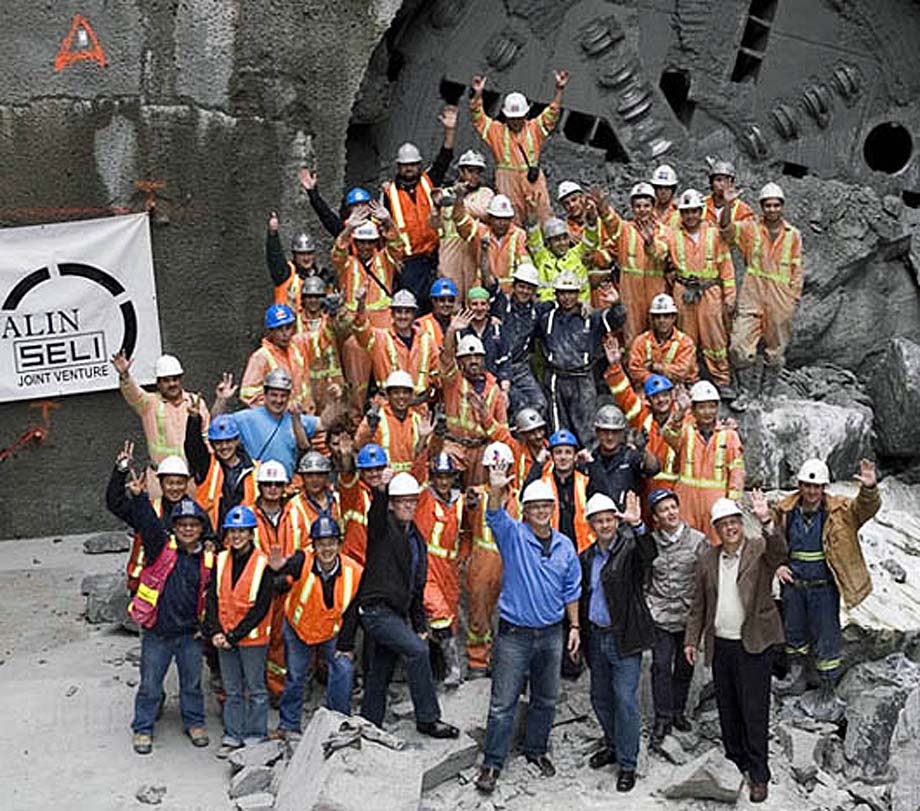Canada Line Construction William Slim |


Vancouver British Columbia - Canada Line's Tunnel Boring Machine (TBM) achieved a milestone today when it broke through the ground north of Pender Street at Granville, the future site of the Canada Line Waterfront Station.
"This is an important breakthrough for us all," said Premier Gordon Campbell. "The city, the region, and the province will all benefit. It shows the power of partnership in opening the Pacific Gateway while we reduce greenhouse gas emissions and stimulate economic growth. Compact and healthy urban development helps make public transit work and it's estimated that this one project will reduce greenhouse gas emissions by 14,000 tons by 2021."
The arrival of the TBM into the Waterfront Station excavation pit signifies the completion of the first of two bored tunnels beneath downtown Vancouver. Premier Campbell noted that the work has been accomplished with no lost time injuries as he presented a certificate recognizing that achievement to Andrea Ciamei, project manager for the SLCP-SELI Joint Venture, which is building the bored tunnels.
"This tunnel breakthrough means we are one step closer to connecting Greater Vancouver's main business districts, which will support the growth and continued prosperity of the region," said Ed Fast, MP for Abbotsford. "Canada's New Government is proud to be involved in Canada's largest transportation infrastructure project, which will contribute to a healthy environment within the Greater Vancouver area."
"Like the launch of the TBM from its starting place at Olympic Village* Station last June, the completion of the first tunnel is a milestone for the construction project," said TransLink chair Malcolm Brodie. "Looking forward, the Canada Line will ensure a more convenient and sustainable transportation option for people in the important north-south corridor that connects Vancouver, Richmond, and Vancouver International Airport."
"The completion of this tunnel marks another milestone in a project that will change the face of transportation in the region, and provide an efficient and sustainable transportation option for airport employees and passengers," added Airport Authority president and CEO Larry Berg. "The Canada Line will add to the status of YVR as being one of the world's top airports."
The TBM machine will now be disassembled and transported back to the 2nd Ave worksite near False Creek to start the second tunnel, which will be completed in the spring of 2008.
The tunnel is 2.5 kilometres in length and has taken 10 months to complete. Approximately 10,000 pre-fabricated concrete lining segments have been used to make the tunnel walls. The tunnel is 5.3 metres in internal diameter and varies in depth between 10 and 30 metres.
The Canada Line rapid transit system will run fully separate from traffic between the transportation hub at Waterfront Centre in Vancouver, the heart of Richmond's civic precinct, and Vancouver International Airport. With 16 stations, two bridges, over nine kilometres of tunnel, parking, and bus facilities, and transit capacity equivalent to 10 road lanes, the Canada Line will be an important new link in the regional transportation network.
The Government of Canada and the government of British Columbia, the Greater Vancouver Transportation Authority (TransLink), and Vancouver International Airport Authority are funding the Canada Line, which is also supported by the Cities of Vancouver and Richmond. The project is overseen by Canada Line Rapid Transit Inc. (CLCO), a subsidiary of TransLink. The line is being designed, built, operated, maintained, and partially financed by InTransitBC.
* Use of "Olympic Village" as a station name is subject to an acceptable license agreement being concluded between the Vancouver Organizing Committee for the 2010 Olympic and Paralympic Winter Games and TransLink and the approval of such license by the International Olympic Committee.
Author unknown.